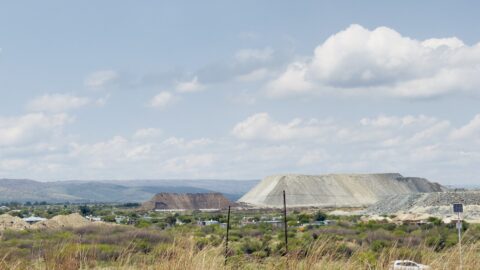Global warming of 2C would see “extensive, long-term [and] essentially irreversible” losses from the Earth’s ice sheets and glaciers, warns a new report.
It would also lead to polar oceans that are “ice-free” in summer and suffering “essentially permanent corrosive ocean acidification”, the report says.
The 2023 “state of the cryosphere” report from the International Cryosphere Climate Initiative (ICCI) lays out the impacts on Earth’s frozen land and seas from sustained warming at 2C and the “catastrophic global damage” that would result.
These impacts would include “potentially rapid, irreversible sea level rise from the Earth’s ice sheets”, the report says, with a “compelling number of new studies” all pointing to thresholds of sustained ice loss for both Greenland and parts of Antarctica at well-below 2C.
This would commit the world to “between 12 and 20 metres” of sea level rise “if 2C becomes the new constant”.
Holding global warming of 2C would also not be enough to “prevent extensive permafrost thaw”, the authors say, bringing additional warming from the resulting CO2 and methane emissions. A 2C world would also see “widespread negative impacts on key fisheries and species” in polar and near-polar oceans.
First published in 2021, the focus of this year’s annual review on how 2C of warming is “too high” shows that the aspirational limit of 1.5C in the Paris Agreement “is not merely preferable to 2C”, but “the only option”, the report says.
The ICCI’s Dr James Kirkham, chief science advisor at the Ambition on Melting Ice high-level group, tells Carbon Brief that the conclusion that 2C is too high for the cryosphere “won’t come as a surprise at all” to most scientists.
With COP28 in Dubai coming later this month, Kirkham says it is time to make “crystal clear” that “2C must now be seen as an unacceptable outcome for the world because of the impacts from the cryosphere”.
In this Q&A, Carbon Brief unpacks the report’s findings for the world’s ice sheets, mountain glaciers, permafrost, sea ice and polar oceans.
- How can ‘very low’ emissions slow impacts on the cryosphere?
- Is the ‘true guardrail’ for preventing dangerous sea level rise actually 1C?
- Is today’s climate already too warm to preserve some mountain glaciers?
- What impact could permafrost emissions have on the carbon budget?
- What are the prospects for sea ice at the Earth’s poles?
- What do rising temperatures and CO2 mean for the polar oceans?
How can ‘very low’ emissions slow impacts on the cryosphere?
Past emissions of CO2 and other greenhouse gases (GHGs) have “pushed the planet into a risk zone”, the report warns, with very visible impacts on the cryosphere:
“Today’s 1.2C above pre-industrial already has caused massive drops in Arctic and Antarctic sea ice; loss of glacier ice in all regions across the planet; accelerating loss from both the Greenland and Antarctic ice sheets; extensive permafrost thaw; and rising polar ocean acidification.”
The implications of these changes stretch beyond the Earth’s poles and mountain regions, the authors note, from accelerating sea level rise and disturbed ocean currents to declining water resources and greater carbon emissions.
Nearly all of these changes “cannot be reversed on human timescales”, the authors warn, and they will continue to grow with each additional 10th of a degree of temperature rise.
Kirkham likens the way the cryosphere responds to warming to a “bowling ball once thrown”. He tells Carbon Brief:
“The changes will continue to roll on long after its initial climatic push because the system has momentum.
“[This means] that many of the long-term challenges associated with the cryosphere are on the cusp of being locked in by decisions made by policymakers in the next few years, and the awareness in the policy world of this ‘lock in’ appears lost right now.”
While the aim of restricting global warming to “well-below” 2C is set out in the Paris Agreement, the report says the “physical reality” of the cryosphere’s response to warming means these changes “would become devastating” well before 2C is reached.
However, warming of 2C is not a “predetermined outcome”, the authors say, arguing that “only a strong, emergency scale course-correction towards 1.5C…can avert higher temperatures, to slow and eventually halt these cryosphere impacts within adaptable levels”.
A “very low” future emissions pathway that would keep warming within, or very close to, 1.5C – the more stringent part of the Paris goal – remains “physically, technologically and economically feasible”, the report says.
This is the “SSP1-1.9” pathway from the set of Shared Socioeconomic Pathways (SSPs) used in the sixth assessment report (AR6) of the Intergovernmental Panel on Climate Change (IPCC).
Under this pathway (see table below), fossil fuel emissions decline 40% by 2030 and global warming peaks at 1.6C before declining to around 1.4C by the end of the century.
| Emissions pathway | Pathway name | Median global warming in 2100 | CO2 levels in 2100 (parts per million) |
|---|---|---|---|
| Very low | SSP1-1.9 | 1.4C (after brief 1.5C overshoot) | 440 ppm |
| Low | SSP1-2.6 | 1.8C (and declining) | 450 ppm |
| Intermediate | SSP2-4.5 | 2.7C (and rising) | 650 ppm |
| High | SSP3-7.0 | 3.6C (and rising) | 800 ppm |
| Very high | SSP5-8.5 | 4.4C (and rising) | 1,000+ ppm |
IPCC AR6 emissions pathways. Credit: ICCI (2023)
Under very low emissions, the Earth’s cryosphere would “generally [begin] to stabilise in 2040-80”, the report says:
“Slow CO2 and methane emissions from permafrost continue for one-two centuries, then cease. Snowpack stabilises, though at lower levels than today. Steep glacier loss continues for several decades, but slows by 2100; some glaciers still will be lost, but others begin to show regrowth. Arctic sea ice stabilises slightly above complete summer loss. Year-round corrosive waters for shelled life are limited to scattered polar and near-polar regions for several thousand years.”
In addition, while “ice sheet loss and sea level rise will continue for several hundred to thousands of years due to ocean warming”, the authors say, it will “likely not exceed three metres globally and occur over centuries”.
All other emissions pathways, including “low” emissions where warming peaks at 1.8C, would “result in far greater committed global loss and damage from [the] cryosphere, continuing over several centuries”, the report warns.
Is the ‘true guardrail’ for preventing dangerous sea level rise actually 1C?
The Earth’s ice sheets on Greenland and Antarctica together hold enough ice to raise global sea levels by 65 metres. The risks of significant amounts of this ice being lost irreversibly on human timescales “increase as temperature and rates of warming rise”, the authors say.
When the ice sheets are in equilibrium, melting ice and the breaking off of icebergs are balanced by mass gain through snowfall. However, “observations now confirm that this equilibrium has been lost” on Greenland, West Antarctica, the Antarctic Peninsula and potentially for portions of East Antarctica, the report says.
This is illustrated in the maps below, which show the gain (blue) and loss (red) in ice on Greenland (left) and Antarctica (right) between 2003 and 2019.

Today, the loss of ice from Greenland is “three times what it was 20 years ago”, the report notes, while Antarctica’s contribution to sea level rise is “six times greater than it was 30 years ago”.
The report paints a bleak picture for the future of both ice sheets. It notes that a “compelling number of new studies” all point to thresholds where irreversible melt becomes inevitable for both Greenland and parts of Antarctica at well below 2C of warming.
This means that were 2C of warming to become “the new constant Earth temperature”, the planet would be committed to between 12 and 20 metres of sea level rise.
For example, evidence from proxy data suggests that, in Earth’s distant past, such thresholds have occurred at around 1C for West Antarctica and the Antarctic Peninsula and between 1.5C and 2C for Greenland, the report says. (These contain enough ice to raise sea levels by around five and seven metres, respectively.) It adds:
“It should be noted that changes around past thresholds were driven by slow increases in atmospheric greenhouse gases, but were paced by slow changes in Earth’s orbit – unlike today’s rapid, human-caused rates of change.”
As a result, “many ice sheet scientists now believe that by 2C, nearly all of Greenland, much of West Antarctica, and even vulnerable portions of East Antarctica will be triggered to very long-term, inexorable sea level rise”.
This occurs because a warmer ocean “will hold heat longer than the atmosphere”, in addition to “a number of self-reinforcing feedback mechanisms, so that it takes much longer for ice sheets to regrow (tens of thousands of years) than to lose their ice”.
This means that “once ice sheet melt accelerates due to higher temperatures, it cannot be stopped or reversed for many thousands of years” – even if temperatures stabilise or even decrease should the world reduce carbon emissions to net-zero, the authors warn.
Lowering sea level rise from newly reached highs would thus “not occur until temperatures go well below pre-industrial, initiating a slow ice sheet regrowth”, the report says:
“Overshooting the Paris Agreement [goal] would therefore cause essentially permanent loss and damage to the Earth’s ice sheets, with widespread impacts that are not reversible on human timescales.”
The report includes the chart below from a 2023 study, which highlights the long-term consequences of global warming. It shows projected global temperature change (top) and the implications for sea level rise (bottom) out to 2150 under four different SSPs.
Under “intermediate” emissions (SSP2-4.5, pink line), which most closely matches the path that the world is on today, sea levels continue to rise. Only “very low” emissions (SSP1-1.9, blue line) would slow and stabilise sea level rise, the report says, “preserving many coastal communities and giving others time to adapt”.

In the face of this evidence, “for a growing number of ice sheet experts”, the true “guardrail” to prevent dangerous levels and rates of sea level rise is “not 2C or even 1.5C, but 1C above pre-industrial”, the report concludes.
Staying as close as possible to the 1.5C limit will “allow us to return more quickly to the 1C level”, the authors say, “drastically slowing global impacts from ice sheet loss and especially West Antarctic ice sheet collapse”.
This would “reduce the risk of locking in significant amounts of long-term, irreversible sea level rise”, the report says. It would also “provide low-lying nations and communities more time to adapt through sustainable development, although some level of managed retreat from coastlines in the long-term is tragically inevitable”.
For world leaders, not committing to reducing emissions in line with the 1.5C limit is “de facto making a decision to erase many coastlines, displacing hundreds of millions of people – perhaps much sooner than we think”, the authors warn.
Is today’s climate already too warm to preserve some mountain glaciers?
Nearly all glaciers in the north Andes, east Africa and Indonesia – along with most mid-latitude glaciers outside the Himalaya and polar regions – could disappear if the 2C warming threshold is breached, the report warns.
Many of these glaciers are “disappearing too rapidly to be saved” even in the present climate and could be gone by 2050, while those large enough to survive the century have “already passed a point of no return”, according to the report’s latest projections.
The figure below shows projections of how much ice glaciers in tropical regions would retain, on average, over the next few centuries under different warming levels in 2100. The lines show the impact of warming by 10ths of a degree between 1.4C and 3C.

At 2C, even the Himalayas are slated to lose around half of today’s ice on average, the report estimates. In a very high emissions scenario, 70-80% of the current glacier volume in the Hindu Kush Himalaya could disappear by 2100, the report says, while low emissions would limit glacier loss to 30%.
Without human-induced warming, glaciers in the northern Andes could have served as a reliable source of water for “hundreds of thousands” of years, the report states. Their loss stands to particularly impact villages in northern Peru, Chile and Bolivia and major cities such as La Paz.
This threat to water security is “one of the greatest challenges posed by a melting cryosphere in a 2C world”, Dr Kirkham tells Carbon Brief, “especially in Asia where freshwater sourced from snow and ice provides a lifeline to over 2 billion people”. He adds:
“This loss of water will even impact some downstream countries that do not contain any snow and ice at all, such as Bangladesh, especially in years when the timing of the monsoon is unreliable.”
Mid-latitude glaciers in the Alps, the Rockies, the southern Andes, Patagonia, Scandinavia and New Zealand are also seeing severe losses.
The report quotes new findings in 2023 showing that the Swiss Alps lost 10% of its glacial ice in just two years over 2022-23, attributed especially to heatwaves, while the Andes witnessed “what may have been the most extreme heatwave on the planet in 2023” in winter.
Warmer temperatures at higher altitudes mean what should be snow is now falling as hazardous extreme rainfall, while other mountain areas face “snow droughts”.
The report finds that most glacier-covered regions outside the Himalaya and the poles have already passed a period of “peak water”, a point at which water availability will only decline each season.
Recovering lost glaciers could take hundreds to thousands of years and temperatures well below the records being set today, the authors note.
However, a low emissions scenario could limit glacier loss in the Himalaya to 30%, with steeper emission cuts stabilising high mountain Asia’s snowpack and glaciers. Some glaciers could eventually even begin to return, the report says.
Rapid cuts consistent with 1.5C of warming could preserve twice as much ice in Central Asia and the southern Andes, the report estimates.
This could benefit vulnerable communities that depend most on glacial water runoff for drinking water and subsistence agriculture while buying them time to adapt to dangerous climate impacts. For instance, one study cited by the report estimates that 15 million people across the world and especially in high mountain Asia and Peru are at risk of glacial lake outburst floods (GLOFs).

A very low emissions pathway could have benefits for cities and economies beyond agriculture, the report notes. The megacities of Delhi, Los Angeles, Marrakech and Kathmandu are all dependent on meltwater, to a degree, while new research shows growing climate-driven threats to hydropower projects in high mountain Asia due to retreating glaciers, thawing permafrost, GLOFs, avalanches and landslides.
Dealing with the changing water supply from glaciers and snow “may render many of these investments defunct before some of the projects are completed”, warns Kirkham.
Countries including Japan, the US and Switzerland also stand to lose significant revenues from snow-based tourism, while also being exposed to increased risk of wildfires and mudslides linked to the lack of snow cover.
The figure below contrasts the state of Switzerland’s Great Aletsch glacier today – the largest glacier in the Alps – with projections under current emissions and very low emissions scenarios in 2060 and 2100.

However, if warming were limited to 1.5C, the annual snowpack could stabilise – even if at a lower average amount than today. It adds:
“This visible snow and ice preservation, and its benefits for freshwater resources, may be one of the earliest and visible signs to humanity that steps towards low emissions have meaningful results.”
Dr Miriam Jackson, senior cryosphere specialist at the International Centre for Integrated Mountain Development (ICIMOD) and author on the mountain glaciers chapter of the report, tells Carbon Brief:
“This latest cryosphere report shows, more clearly than ever, that we have a choice. We can continue as we are now and see 80% of glacier loss by the end of this century. Or we can follow a very low emissions pathway, where glaciers and snow cover in high mountain Asia stabilise and eventually begin to return. Millions of people’s livelihoods depend on us making the second choice.”
What impact could permafrost emissions have on the carbon budget?
A global temperature rise of 2C – “and even 1.5C” – is too high to prevent the widespread thawing of an icy layer spread across more than one-fifth of the northern hemisphere’s land, the report says.
Permafrost is a mixture of soil, rock and other materials on or under the Earth’s surface that has been frozen for at least two years. It stores a huge amount of ancient, organic carbon.
Research shows that permafrost areas are rapidly warming and, as a result, thawing. This process releases some of the stored carbon into the atmosphere as CO2 and methane, further fuelling global warming. This is known as a “positive feedback”.
“These emissions are irreversibly set in motion”, the report says, and will not slow for one-to-two centuries even if permafrost re-freezes at a later point.
This means that permafrost emissions can further diminish the remaining global “carbon budget” – the amount of CO2 that can still be released while keeping warming below global limits of 1.5 or 2C.
The report says that carbon budget calculations “must take these indirect human-caused emissions from permafrost thaw into account…not just through [to] 2100, but well into the future”. It adds:
“Permafrost emissions today and in the future are on the same scale as large industrial countries, but can be minimised if the planet remains at lower temperatures.”
The chart below shows the impact of permafrost emissions (pink shaded areas) on the remaining carbon budget (red bars) to stay within 1.5C and 2C of warming. Taking permafrost emissions into account significantly reduces the budget estimates, the report says.

Prof Julie Brigham-Grette, the geosciences graduate programme director at the University of Massachusetts Amherst and author on the report, says she is “very concerned” about permafrost thaw. She tells Carbon Brief:
“The bottom line is that we must reduce fossil fuel use urgently to slow down the demise of glaciers, ice sheets, permafrost, snow cover, sea ice…The climate crisis is real and it’s a threat-multiplier to social and political systems around the world.”
Currently, at 1.2C of warming, the annual emissions from permafrost are about the same as Japan – the sixth largest emitting country, based on 2019 figures, the report says.
Keeping temperatures below 1.4C would prevent “most additional new thaw”, the report says. But even at 1.5C, scientists predict a 40% loss of near-surface permafrost areas by 2100.
At a 2C global temperature rise, permafrost thawing and associated emissions would continue to climb.
At temperatures of 3C or higher by the end of this century, “much of the Arctic, and nearly all mountain” permafrost would reach the “thawed state”, where it would produce the equivalent of the combined annual GHG emissions of the US and the EU in 2019, for centuries, the report says.

As much as half of recent permafrost thaw occurred during extreme temperature events that were up to 12C above average, the authors say.
But the report notes that current global climate models do not include these “abrupt thaw” processes in their predictions. Scientists are “still working on these phenomena and what it means for emission rates”, Brigham-Grette says.
Studies analysed in the report found that, overall, permafrost thaw will have a number of “cascading impacts” with “severe” effects already being felt in the Arctic. The report adds:
“Thawing permafrost is causing the loss of Arctic lands, threatening cultural and subsistence resources, and damaging infrastructure, like roads, pipelines and houses, as the ground sinks unevenly beneath them.”
The “only means available” to reduce the problem is to “keep as much permafrost as possible in its current frozen state” and limiting global warming to 1.5C, according to the report.
What are the prospects for sea ice at the Earth’s poles?
Sea ice at the Earth’s poles undergoes an annual cycle of melting and regrowth. In the Arctic, sea ice melts during the warmer summer months towards its September minimum, before regrowing in the colder winter months. However, as the planet warms, sea ice extent at the September minimum is declining.
The area of Arctic sea ice that “survives” the summer has declined by at least 40% since 1979, the report says. Furthermore, it says, the Arctic ocean has “become dominated by a thinner, faster moving covering of seasonal ice, which typically doesn’t survive the summer”, as opposed to thick, multiyear sea ice.
The authors add:
“Ninety percent of Arctic sea ice loss can be directly attributed to anthropogenic emissions. A threshold has now been crossed in which ice-free conditions in the month of September will occur at times even with very low emissions, and with much slower and later surface freeze-up.”
There is widespread public and scientific interest in when the Arctic might see its first “ice-free” summer. The report highlights a recent study that suggests Arctic sea ice is more sensitive to GHG emissions than was described in the IPCC AR6 report.
The figure below shows projections of September Arctic sea ice area for different emissions scenarios. The different coloured lines indicate different models and the horizontal red line shows the threshold for a “practically ice-free” Arctic, which is one million square kilometres of ice. The lowest emission scenario is shown on the left and the highest emission scenario on the right.

The graphic shows that only the SSP1-1.9 scenario results in “sea ice recovery above ice-free conditions”. At 2C warming, the Arctic Ocean will be sea ice-free in summer “almost every year”, the report says.
The report concludes that the occurrence of the first ice-free Arctic summer is “unpredictable”, but “inevitable”, adding that it is likely to occur at least once before 2050 even under a “very low” emissions scenario.
Dr Zachary Labe is a postdoctoral research associate at the NOAA Geophysical Fluid Dynamics Laboratory and the Atmospheric and Oceanic Sciences Program at Princeton University, and was not involved in writing the report.
He praises the report, but adds:
“There are countless studies that have evaluated future Arctic sea ice trajectories using models and emergent constraint-like methods, so I advise caution in overly relying on mostly one new study.”
At the Earth’s other pole, Antarctic sea ice saw record-breaking melt in 2023 setting a summer minimum in February 2023. “The unprecedented reduction in Antarctic sea ice extent since 2016 represents a regime shift to a new state of inevitable decline caused by ocean warming,” the authors say.
According to the report, sea ice projections around Antarctica are “considerably less certain” than those in the Arctic. However, the authors say the record-low conditions in 2023 “indicate that its threshold for complete summer sea ice loss might be even lower than for the Arctic”.
The authors also highlight recent research that found thousands of emperor penguin chicks died because of the early breakup of Antarctic sea ice in 2022.
“Perhaps more so than for any other part of the cryosphere, 2C is far too high to prevent extensive sea ice loss at both poles, with severe feedbacks to global weather and climate,” the authors conclude.
What do rising temperatures and CO2 mean for the polar oceans?
The world’s oceans absorb around one-quarter of all human-produced CO2, which reacts with seawater to produce a weak acid in a process called ocean acidification.
Rates of ocean acidification are currently faster than they have been at any point in the past 300m years, the report finds. Polar waters in the Arctic and Southern oceans have absorbed up to 60% of the carbon taken up by the world’s oceans so far, because colder and fresher waters can hold more carbon, it notes, adding:
“The Arctic Ocean appears to be most sensitive: already today, it has large regions of persistent corrosive waters.”
In 2008, a group of scientists identified atmospheric CO2 levels of 450 parts per million (ppm) as an important threshold for “serious global ocean acidification”, according to the report. This atmospheric CO2 threshold corresponds to around 1.5C warming, it says.
However, it says that current national pledges to reduce emissions under the Paris Agreement – even if completely fulfilled – will result in CO2 levels above 500ppm, resulting in temperatures of around 2.1C.
The maps below show ocean acidification in scenarios of 3-4C (top) and a 1.5C (bottom) of warming by 2100. Red shading shows “undersaturated aragonite conditions” – a measure of ocean acidification meaning that shelled organisms have difficulty building or maintaining their shells. Darker red indicates greater levels of ocean acidification.

“There is currently no practical way for humans to reverse ocean acidification,” the authors warn, adding that it will take some 30-70,000 years to bring acidification and its impacts back to pre-industrial levels.
As polar oceans become more acidic, they are also warming at an “unusually rapid” rate, the report warns. The authors note that since 1982, summer surface water temperatures in the Arctic have increased by around 2C – mainly due to sea-ice loss that allows the sun’s rays to hit the water, and an inflow of warmer water from lower latitudes.
The map below shows the change in sea surface temperature over 1993-2021. Red indicates warming and blue indicates cooling, while the white at the highest polar latitudes is due to incomplete data for this period.

The map shows that near-polar waters such as the Barents Sea have warmed “extensively” over the past two decades. The colder patch in the south of Greenland is an exception which is partly due to cold freshwater being added as the Greenland ice sheet melts, it adds.
The authors add that increased run-off from glaciers, ice sheets and rivers is also affecting global ocean circulation, which could stall ocean currents such as the Atlantic Meridional Overturning Circulation (AMOC).
The report also warns that the dual impacts of ocean acidification and warming could have severe impacts for polar biodiversity, adding that “polar waters contain some of the world’s richest fisheries and most diverse marine ecosystems”.
Over the past decade, many polar species have experienced “lethal” temperatures which have caused mass-die offs, the report warns.
It also highlights the dangers of ocean acidification, including harm to key ocean-dwelling organisms which could “cascade” up the food chain. “Compound events combining marine heatwaves and extreme acidification have already caused population crashes even at today’s 1.2C,” the authors say.
The report concludes:
“2C will result in year-round, essentially permanent corrosive conditions in extensive regions of Earth’s polar and some near-polar seas; with widespread negative impacts on key fisheries and species.”
The post Q&A: Warming of 2C would trigger ‘catastrophic’ loss of world’s ice, new report says appeared first on Carbon Brief.
Q&A: Warming of 2C would trigger ‘catastrophic’ loss of world’s ice, new report says
Climate Change
EU refuses to review “strategic” mineral projects for energy transition
The European Commission has rejected requests by green groups to review the status of 16 controversial projects it has designated as “strategic” to shore up the bloc’s supply of critical minerals needed for the energy transition, despite environmental concerns.
Campaigners accused the European Union’s executive arm of being more interested in labelling projects as “strategic” to accelerate their development than ensuring they meet its environmental standards.
Legal experts told Climate Home News that despite the EU’s rhetoric on developing sustainable mining standards, it will be very difficult for local communities and NGOs to use the judicial system to enforce compliance with environmental safeguards.
Earlier this year, the European Commission labelled 47 mineral extraction, processing and recycling projects within EU member states as “strategic“, granting them preferential treatment for gaining permits and easier access to EU funding.
Spanning from the north of Sweden to Portugal and southern Spain, these projects are due to help the EU reach targets for sourcing more of the minerals it needs for clean energy and digital technologies within its own borders in an environmentally friendly way, while reducing its dependence on imports from China.
However, NGOs and local communities have accused the European Commission of a lack of transparency and of failing to engage civil society over the selection of these projects, most of which are in the early stages of development and are yet to obtain the necessary permits or conduct detailed environmental impact assessments.
Civil society groups challenged the decision to include around a third of projects on the strategic list, arguing that the commission had not properly assessed their sustainability. They also cited risks of social and environmental harm and human rights violations.
EU: Environmental compliance lies with member states
In total, 11 requests for review covering 16 of the projects planned within the EU were filed under the Aarhus Regulation, which gives NGOs the right to ask the European Commission to review administrative decisions if they are considered to violate the bloc’s environmental law.
In a single response shared with green groups this week, and seen by Climate Home News, the commission found that the requests to review the projects’ status were “unfounded”.
“A thorough assessment confirmed that all points raised by the NGOs had already been properly addressed during the selection process. All the projects concerned therefore retain their status as strategic projects,” a European Commission spokesperson told Climate Home News. They did not respond to detailed questions about their assessment.
Under the EU’s Critical Raw Materials Act, which was adopted last year, the commission can designate mineral projects as strategic if they meet a shortlist of criteria, including that the project “would be implemented sustainably” and monitor, prevent and minimise environmental and adverse social impacts.
The strategic status can be revoked if projects no longer meet the criteria.
However, the commission said it was not its job to carry out a full and detailed assessment of whether the projects fully comply with EU environmental laws, adding that it is only required to make an “overall assessment”.
Rather, it argued, member states have the responsibility to ensure the projects fully comply with EU environmental standards including impacts on biodiversity and ground water as well as waste management.
The commission also refused to examine the social impacts of the projects on community livelihoods, health and human rights – which could arise from environmental degradation – arguing that this was outside the scope of the review mechanism under the Aarhus Regulation.
Campaigners have strongly criticised the response.
“Cosmetic”sustainability criteria
Ilze Tralmaka, a lawyer at Client Earth, told Climate Home News the commission’s decision showed that the designation of mineral projects as “strategic” doesn’t make them safe or sustainable, despite creating a legal presumption that they serve the public interest and protect public health and safety.
“While on paper, there is mention of sustainability, in practice, it’s almost cosmetic,” she said. “It seems the environmental standards are just briefly looked at and that the policy of declaring these projects as strategic is more important than real engagement with the sustainability criteria.”
Client Earth argues that while securing supplies of minerals for the energy transition is a legitimate goal, the status of strategic project is being “misused” to fast-track questionable mining projects.
Tralmaka said the European Commission should engage where there are “unanswered questions, or if there is credible information about these projects being potentially unsafe”.
Client Earth was part of a group of NGOs that challenged the decision to designate the Barroso lithium project in Portugal as a strategic project.
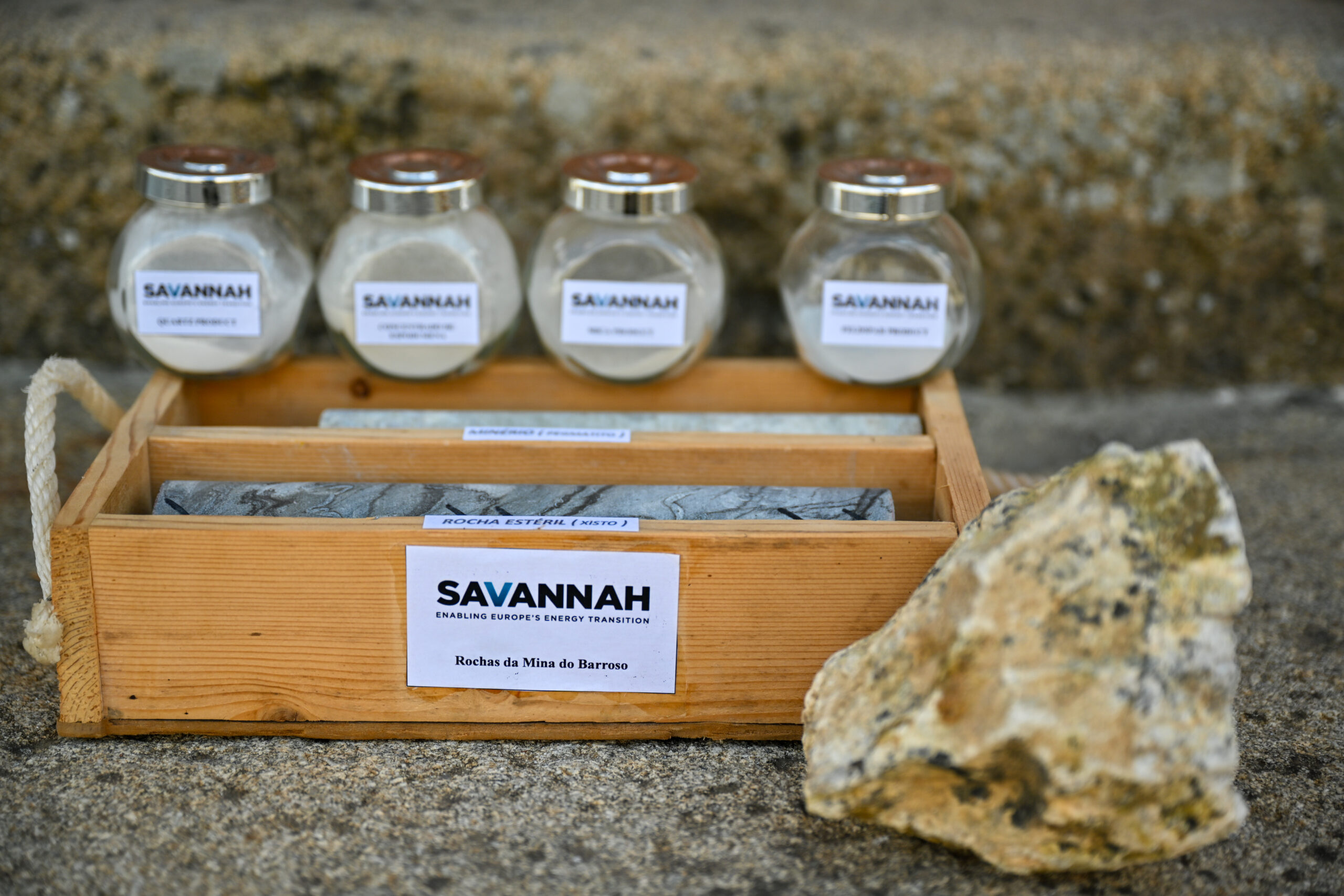

“Textbook example of how not to do a green transition”
London-listed Savannah Resources is planning to dig four open pit mines in the northern Barroso region to extract lithium from Europe’s largest known deposit. The company says it will extract enough lithium every year to produce around half a million batteries for electric vehicles.
However, local groups have staunchly opposed the mining project, citing concerns over waste management and water use as well as the impact of the mine on traditional agriculture in the area.
Earlier this year, a UN committee found that Portugal had failed to respect citizens’ rights to information and public participation in the case of the Barroso project. Portuguese authorities denied the breach.
Efforts to green lithium extraction face scrutiny over water use
The commission said it was satisfied with the project’s overall sustainability credentials and that campaign groups should take a case to their national court if they are concerned about the legality of any project.
“This decision shows that the EU is willing to trade rural lives and irreplaceable landscapes for a political headline,” said Nik Völker of MiningWatch Portugal. “The truth is, the Mina do Barroso mine offers minimal benefits and enormous risks: a textbook example of how not to do a green transition.”
Savannah Resources did not respond to a request for comment.
“Murky” standards make legal challenge hard
Simon Simanovski, a business and human rights attorney with German law firm Günther Rechtsanwälte, has advised dozens of communities affected by projects designated as “strategic” under the EU’s Critical Raw Materials Act over the past year.
For him, the commission’s response creates a disconnect between its role as a decision-making body and the responsibility for enforcing the bloc’s environmental laws, by pushing it to member states. That, he said, creates “murky standards”.
This, he added, will make it “really difficult” to challenge inadequate environmental safeguards through the courts. “It means that there is no effective judicial protection… and that the projects will happen,” he told Climate Home News.
However, Simanovski still expects some campaign groups to try filing a case before the general court of the European Court of Justice to challenge the European Commission’s response and ask it to review its assessment of the projects.
Simanovski represents communities in Serbia that are also challenging the “strategic” designation of the Jadar lithium mine – one of an additional 13 “strategic projects” located outside EU countries – which has seen massive local opposition.
The commission is expected to respond to requests to review those external strategic projects in January.
The post EU refuses to review “strategic” mineral projects for energy transition appeared first on Climate Home News.
EU refuses to review “strategic” mineral projects for energy transition
Climate Change
DeBriefed 28 November 2025: COP30’s ‘frustrating’ end; Asia floods; UK ‘emergency’ climate event
Welcome to Carbon Brief’s DeBriefed.
An essential guide to the week’s key developments relating to climate change.
This week
‘Lukewarm’ end to COP30
BYE BELÉM: The COP30 climate talks in Belém ended last weekend with countries agreeing on a goal to “triple” adaptation finance by 2035 and efforts to “strengthen” climate plans, Climate Home News reported. The final deal “fell short on the global transition away from oil, gas and coal”, the outlet said, as Brazil announced that it would bring forward voluntary roadmaps to phase out fossil fuels and deforestation, before the next COP. It was a “frustrating end” for more than 80 countries who wanted a roadmap away from fossil fuels to be part of the formal COP agreement, BBC News said.
WHAT HAPPENED?: Carbon Brief published its in-depth analysis of all the key outcomes from COP30, spanning everything from negotiations on adaptation, just transition, gender and “Article 6” carbon trading through to a round-up of pledges on various issues. Another Carbon Brief article summed up outcomes around food, forests, land and nature. Also, Carbon Brief journalists discussed the COP in a webinar held earlier this week.
ART OF THE DEAL: The “compromise” COP30 deal – known as the “global mutirão” – “exposed deep rifts over how future climate action should be pursued”, Reuters noted. The “last-ditch” agreement was reached after fossil-fuel wording negotiations between the EU and Saudi Arabia, according to the Guardian. Meanwhile, Carbon Brief revealed the “informal” list of 84 countries said to have “opposed” the inclusion of a fossil-fuel roadmap in the mutirão decision, but analysis of the list exposed contradictions and likely errors.
UNITY, SCIENCE, SENSE: The final agreement received “lukewarm praise”, said the Associated Press. Palau ambassador Ilana Seid, who chaired the coalition of small-island nations, told the newswire: “Given the circumstances of geopolitics today, we’re actually quite pleased…The alternative is that we don’t get a decision and that would have been [worse].” UN climate chief Simon Stiell said that amid “denial, division and geopolitics”, countries “chose unity, science and economic common sense”, reported the Press Trust of India.
Around the world
- Floods and landslides killed more than 200 people in Thailand and Indonesia this week, reported Bloomberg. At least 90 people also died in recent floods in Vietnam, said Al Jazeera.
- New measures to cut energy bills and a “pay-per-mile” electric-vehicle levy were among the announcements in the UK’s budget, said Carbon Brief.
- The Group of 20 (G20) leaders signed off on a declaration “addressing the climate crisis” and other issues, reported Reuters, which had no input from the US who boycotted last week’s G20 summit in South Africa.
- Canadian prime minister Mark Carney signed a deal with the province of Alberta “centred on plans for a new heavy oil pipeline”, said the Guardian, adding that Canadian culture minister and former environment minister, Steven Guilbeault, resigned from cabinet over the deal.
- Greenpeace analysis, covered by Reuters, found that permits for new coal plants in China are “on track to fall to a four-year low” in 2025.
27
The number of hours that COP30 talks went over schedule before ending in Belém last Saturday, making it the 11th-longest UN climate summit on record, according to analysis by Carbon Brief.
Latest climate research
- The risk of night-time deaths during heatwaves increased “significantly” over 2005-15 in sub-Saharan Africa | Science Advances
- Almost half of climate journalists surveyed showed “moderate to severe” symptoms of anxiety | Traumatology
- Lakes experienced “more severe” heatwaves than those in the atmosphere over the past two decades | Communications Earth & Environment
(For more, see Carbon Brief’s in-depth daily summaries of the top climate news stories on Monday, Tuesday, Wednesday, Thursday and Friday.)
Captured
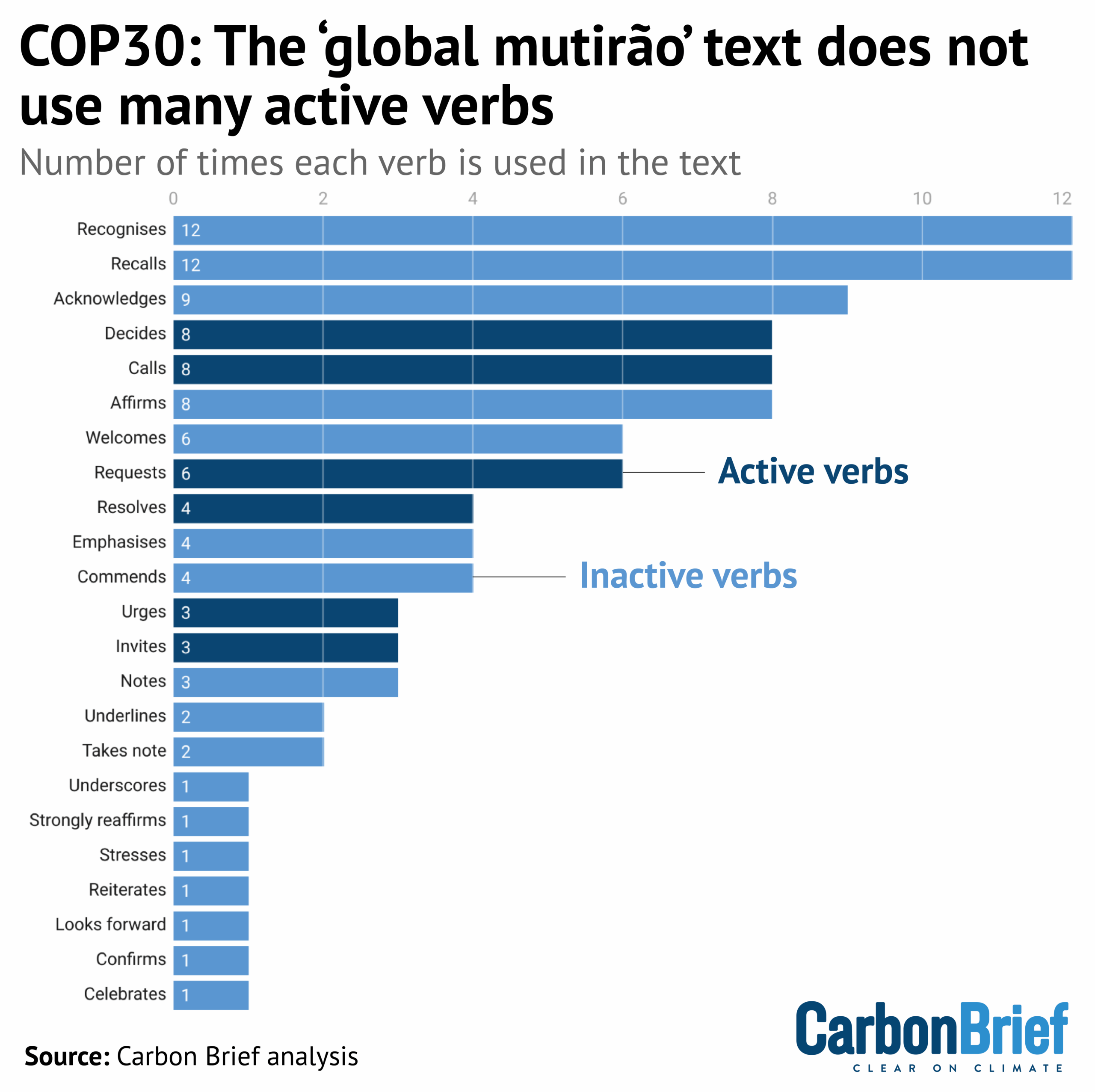
The key COP30 agreement – termed the “global mutirão” – contained 69 inactive verbs, which require no action from countries, compared to 32 active ones. “Recognises”, “recalls” and “acknowledges” were used far more often than more active verbs, such as “decides”, “calls” and “requests”, showed Carbon Brief analysis.
Spotlight
Nine warnings from a UK climate and nature ‘emergency’ briefing
This week, Carbon Brief’s Orla Dwyer reports from an event where experts and campaigners sounded the alarm bell on climate change and nature loss.
Naturalist and broadcaster Chris Packham urged attendees at a climate and nature “emergency briefing” in London yesterday to “listen to the science” on climate change amid a “dangerous wave of misinformation and lies”.
The “first-of-its-kind” event heard from nine experts on the links between climate change, nature loss, health, food production, economics and national security.
Event host, Prof Mike Berners-Lee from Lancaster University, called for a “World War II level of leadership” to tackle the interconnected crises.
Hundreds of people showed up, including Green Party, Labour and Liberal Democrat MPs, leader of the Greens Zack Polanski, musician Brian Eno and actress Olivia Williams.
Here is a snapshot of what the nine speakers said in their short, but stark, presentations.
Prof Kevin Anderson, professor of energy at University of Manchester
Anderson focused on the risks of a warmer world and the sliver of emissions left in the global carbon budget, noting:
“We have to eliminate fossil fuels or temperatures will just keep going up.”
He urged a “Marshall-style” plan – referencing the 1948 post-war US plan to rebuild Europe – to ramp up actions on retrofitting, public transport and electrification.
Prof Nathalie Seddon, professor of biodiversity at University of Oxford
Nature is not a “nice to have”, but rather “critical national infrastructure”, Seddon told attendees. She called for the “need to create an economy that values nature”.
Prof Paul Behrens, British Academy global professor at University of Oxford
Behrens discussed the food security risks from climate change. Impacts such as poor harvests and food price inflation are “barely acknowledge[d]” in agricultural policy, he said.
He also emphasised the “unsustainable” land use of animal agriculture, which “occupies around 85% of total agricultural land” in the UK.
Prof Tim Lenton, chair in climate change and Earth system science at Exeter University
Lenton outlined the “plenty” of evidence that parts of the Earth system are hurtling towards climate tipping points that could push them irreversibly into a new state.
He discussed the possibility of the shutdown of the Atlantic Meridional Overturning Circulation, which he said could cause -20C winters in London. He also noted positive tipping points, such as momentum that led the UK to stop burning coal for electricity last year.
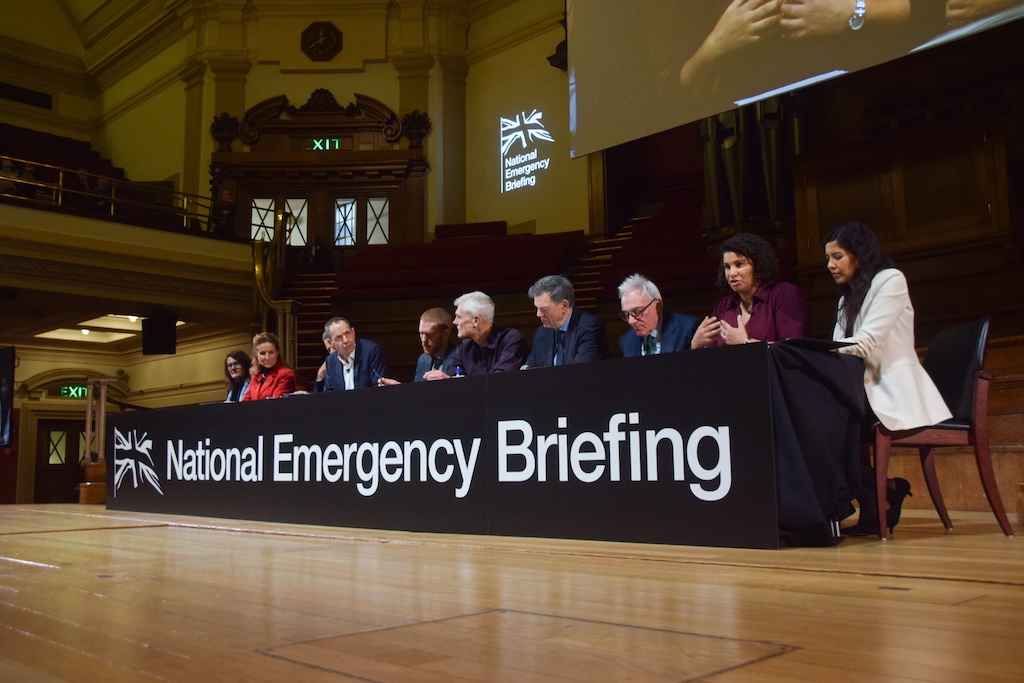
Prof Hayley Fowler, professor of climate change impacts at Newcastle University
One in four properties in England could be at risk of flooding by 2050, Fowler said, and winters are getting wetter.
She discussed extreme weather risks and listed the impacts of floods in recent years in Germany, Spain and Libya, adding:
“These events are not warnings of what might happen in the future. They’re actually examples of what is happening right now.”
Angela Francis, director of policy solutions at WWF-UK
Francis factchecked several claims made against climate action, such as the high cost of achieving net-zero.
She noted that the estimated cost for the UK to achieve net-zero is about £4bn per year, which is less than 0.2% of GDP.
Lieutenant general Richard Nugee, climate and security advisor
Discussing the risks climate change poses to national security, Nugee said:
“Climate change can be thought of as a threat multiplier, making existing threats worse or more frequent and introducing new threats. Climate shocks fuel global instability.”
Tessa Khan, environmental lawyer and executive director of Uplift
Khan said the rising cost of energy in the UK is “turning into a significant political risk for the energy transition”.
She discussed the cost of fossil-fuel dependency and the fact that these fuels cost money to burn, but renewable “input[s], sun or wind [are] free forever”.
Prof Hugh Montgomery, professor of intensive care medicine at University College London
Montgomery discussed the health and economic benefits of climate actions, such as eating less meat and using more public transport, noting:
“The climate emergency is a health emergency – and it’s about time we started treating it as one.”
Watch, read, listen
WATER WORRIES: ABC News spoke to three Iranian women about the impacts of Tehran’s water crisis amid the “worst drought in 60 years”.
CLIMATE EFFORT: The BBC’s Climate Question podcast looked at the main outcomes from COP30 and discussed the “future of climate action” with a team of panelists.
CRIMINAL BEHAVIOUR:New Scientist interviewed criminal psychologist Julia Shaw about the psychology behind environmental crimes.
Coming up
- 24 November-5 December: COP20 on international trade in endangered species of wild fauna and flora, Samarkand, Uzbekistan
- 29-30 November: First part of global youth environment assembly, Nairobi, Kenya
- 3-4 December: Second round of Egyptian parliamentary elections
- 5 December: World soil day, global
Pick of the jobs
- Aldersgate Group, head of policy | Salary: £56,650-£66,950 per year. Location: London
- Ofgem, climate resilience expert | Salary: £61,446-£86,547. Location: Cardiff, Glasgow or London
- Green Climate Fund, integrity risk management lead | Salary: $171,200. Location: Incheon, South Korea
- Isles of Scilly Wildlife Trust, project manager – seabird recovery | Salary: Up to £45,000 per year. Location: Isles of Scilly, UK
DeBriefed is edited by Daisy Dunne. Please send any tips or feedback to debriefed@carbonbrief.org.
This is an online version of Carbon Brief’s weekly DeBriefed email newsletter. Subscribe for free here.
The post DeBriefed 28 November 2025: COP30’s ‘frustrating’ end; Asia floods; UK ‘emergency’ climate event appeared first on Carbon Brief.
DeBriefed 28 November 2025: COP30’s ‘frustrating’ end; Asia floods; UK ‘emergency’ climate event
Climate Change
Revealed: Leak casts doubt on COP30’s ‘informal list’ of fossil-fuel roadmap opponents
A confused – and, at times, contradictory – story has emerged about precisely which countries and negotiating blocs were opposed to a much-discussed “roadmap” deal at COP30 on “transitioning away from fossil fuels”.
Carbon Brief has obtained a leaked copy of the 84-strong “informal list” of countries that, as a group, were characterised across multiple media reports as “blocking” the roadmap’s inclusion in the final “mutirão” deal across the second week of negotiations at the UN climate summit in Belém.
During the fraught closing hours of the summit, Carbon Brief understands that the Brazilian presidency told negotiators in a closed meeting that there was no prospect of reaching consensus on the roadmap’s inclusion, because there were “80 for and 80 against”.
However, Carbon Brief’s analysis of the list – which was drawn up informally by the presidency – shows that it contains a variety of contradictions and likely errors.
Among the issues identified by Carbon Brief is the fact that 14 countries are listed as both supporting and opposing the idea of including a fossil-fuel roadmap in the COP30 outcome.
In addition, the list of those said to have opposed a roadmap includes all 42 of the members of a negotiating group present in Belém – the least-developed countries (LDCs) – that has explicitly told Carbon Brief it did not oppose the idea.
Moreover, one particularly notable entry on the list, Turkey – which is co-president of COP31 – tells Carbon Brief that its inclusion is “wrong”.
Negotiating blocs
COP28, held in Dubai in 2023, had finalised the first “global stocktake”, which called on all countries to contribute to global efforts, including a “transition away from fossil fuels”.
Since then, negotiations on how to take this forward have faltered, including at COP29 in Baku, Azerbaijan, where countries were unable to agree to include this fossil-fuel transition as part of existing or new processes under the UN climate regime.
Ahead of the start of COP30, Brazilian president Luiz Inácio Lula da Silva made a surprise call for “roadmaps” on fossil-fuel transition and deforestation.
While this idea was not on the official agenda for COP30, it had been under development for months ahead of the summit – and it became a key point of discussion in Belém.
Ultimately, however, it did not become part of the formal COP30 outcome, with the Brazilian presidency instead launching a process to draw up roadmaps under its own initiative.
This is because the COP makes decisions by consensus. The COP30 presidency insisted that there was no prospect of consensus being reached on a fossil-fuel roadmap, telling closed-door negotiations that there were “80 for and 80 against”.
The list of countries supporting a roadmap as part of the COP30 outcome was obtained by Carbon Brief during the talks. Until now, however, the list of those opposed to the idea had not been revealed.
Carbon Brief understands that this second list was drawn up informally by the Brazilian presidency after a meeting attended by representatives of around 50 nations. It was then filled out to the final total of 84 countries, based on membership of negotiating alliances.
The bulk of the list of countries opposing a roadmap – some 39 nations – is made up of two negotiating blocs that opposed the proposal for divergent reasons (see below). Some countries within these blocs also held different positions on why – or even whether – they opposed the roadmap being included in the COP30 deal.
These blocs are the 22-strong Arab group – chaired in Belém by Saudi Arabia – and the 25 members of the “like-minded developing countries” (LMDCs), chaired by India.
For decades within the UN climate negotiations, countries have sat within at least one negotiating bloc rather than act in isolation. At COP30, the UN says there were 16 “active groups”. (Since its invasion of Ukraine, Russia has not sat within any group.)
The inclusion on the “informal list” (shown in full below) of both the LMDCs and Arab group is accurate, as confirmed by the reporting of the International Institute for Sustainable Development’s Earth Negotiations Bulletin (ENB), which is the only organisation authorised to summarise what has happened in UN negotiations that are otherwise closed to the media.
Throughout the fortnight of the talks, both the LMDCs and Arab group were consistent – at times together – in their resistance to proscriptive wording and commitments within any part of the COP30 deal around transitioning away from fossil fuels.
But the reasons provided were nuanced and varied and cannot be characterised as meaning both blocs simply did not wish to undertake the transition – in fact, all countries under the Paris Agreement had already agreed to this in Dubai two years ago at COP28.
However, further analysis by Carbon Brief of the list shows that it also – mistakenly – includes all of the members of the LDCs, bar Afghanistan and Myanmar, which were not present at the talks. In total, the LDCs represented 42 nations in Belém, ranging from Bangladesh and Benin through to Tuvalu and Tanzania.
Some of the LDC nations had publicly backed a fossil-fuel roadmap.
‘Not correct’
Manjeet Dhakal, lead adviser to the LDC chair, tells Carbon Brief that it is “not correct” that the LDCs, as a bloc, opposed a fossil-fuel roadmap during the COP30 negotiations.
He says that the group’s expectations, made public before COP, clearly identified transitioning away from fossil fuels as an “urgent action” to keep the Paris Agreement’s 1.5C goal “within reach”. He adds:
“The LDC group has never blocked a fossil-fuel roadmap. [In fact], a few LDCs, including Nepal, have supported the idea.”
Dhakal’s statement highlights a further confusing feature of the informal list – 14 countries appear on both of the lists of supporters and opposers. This is possible because many countries sit within two or more negotiating blocs at UN climate talks.
For example, Kiribati, Solomon Islands and Tuvalu are members of both the “alliance of small island states” (AOSIS) and the LDCs.
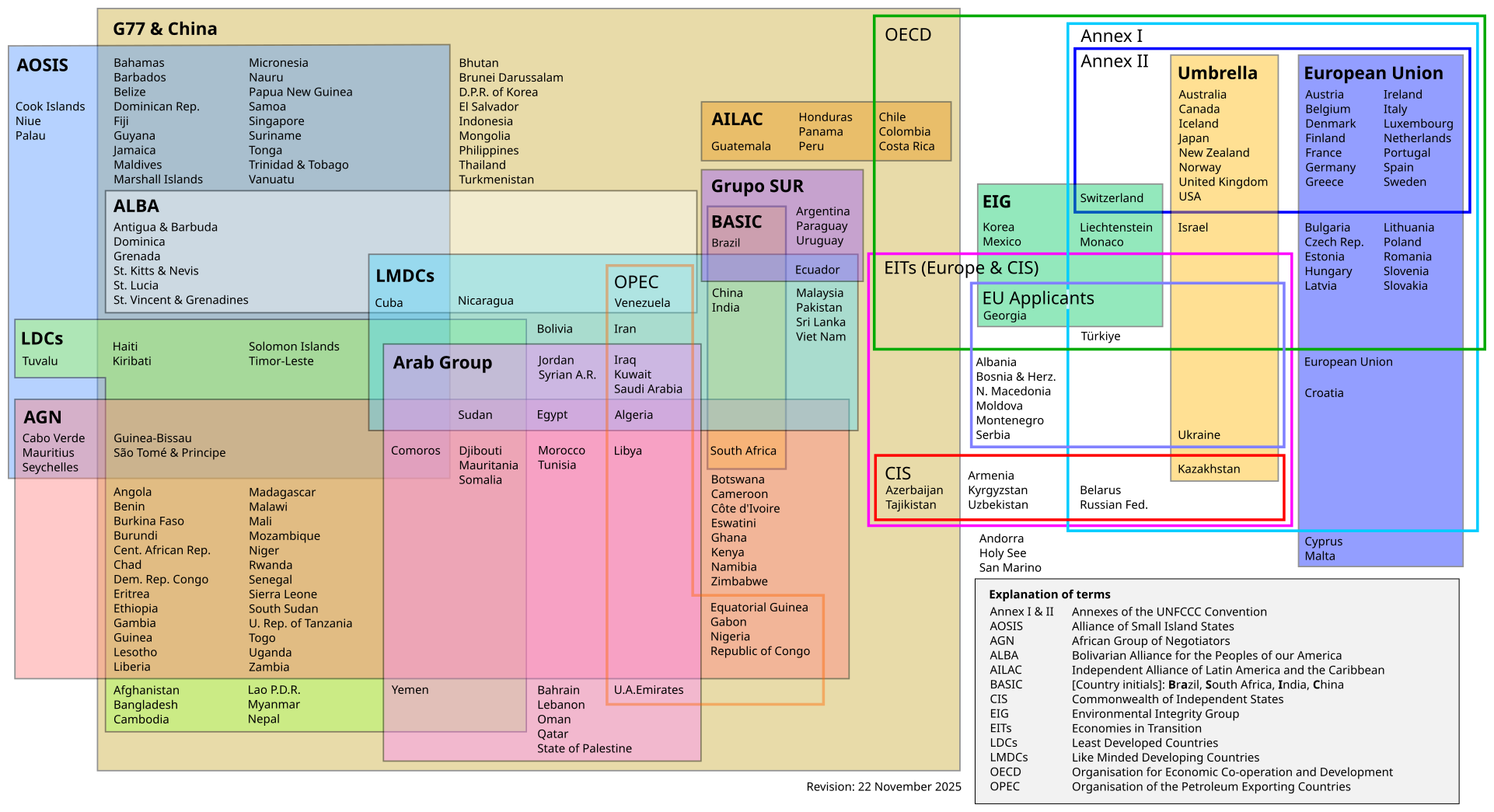
As is the case with the “informal list” of opposers, the list of supporters (which was obtained by Carbon Brief during the talks) is primarily made up of negotiating alliances.
Specifically, it includes AOSIS, the “environmental integrity group” (EIG), the “independent association of Latin America and the Caribbean” (AILAC) and the European Union (EU).
In alphabetical order, the 14 countries on both lists are: Bahrain; Bulgaria; Comoros; Cuba; Czech Republic; Guinea-Bissau; Haiti; Hungary; Kiribati; Nepal; Sierra Leone; Solomon Islands; Timor-Leste; and Tuvalu.
This obvious anomaly acts to highlight the mistaken inclusion of the LDCs on the informal list of opposers.
The list includes 37 of the 54 nations within the Africa group, which was chaired by Tanzania in Belém.
But this also appears to be a function of the mistaken inclusion of the LDCs in the list, many of which sit within both blocs.
Confusion
An overview of the talks published by the Guardian this week reported:
“Though [Brazil’s COP30 president André Corrêa do Lago] told the Guardian [on 19 November] that the divide over the [roadmap] issue could be bridged, [he] kept insisting 80 countries were against the plan, though these figures were never substantiated. One negotiator told the Guardian: ‘We don’t understand where that number comes from.’
“A clue came when Richard Muyungi, the Tanzanian climate envoy who chairs the African group, told a closed meeting that all its 54 members aligned with the 22-member Arab Group on the issue. But several African countries told the Guardian this was not true and that they supported the phaseout – and Tanzania has a deal with Saudi Arabia to exploit its gas reserves.”
Adding to the confusion, the Guardian also said two of the most powerful members of the LMDCs were not opposed to a roadmap, reporting: “China, having demurred on the issue, indicated it would not stand in the way [of a roadmap]; India also did not object.”
Writing for Climate Home News, ActionAid USA’s Brandon Wu said:
“Between rich country intransigence and undemocratic processes, it’s understandable – and justifiable – that many developing countries, including most of the Africa group, are uncomfortable with the fossil-fuel roadmap being pushed for at COP30. It doesn’t mean they are all ‘blockers’ or want the world to burn, and characterising them as such is irresponsible.
“The core package of just transition, public finance – including for adaptation and loss and damage – and phasing out fossil fuels and deforestation is exactly that: a package. The latter simply will not happen, politically or practically, without the former.”
Carbon Brief understands that Nigeria was a vocal opponent of the roadmap’s inclusion in the mutirão deal during the final hours of the closed-door negotiations, but that does not equate to it opposing a transition away from fossil fuels. This is substantiated by the ENB summary:
“During the…closing plenary…Nigeria stressed that the transition away from fossil fuels should be conducted in a nationally determined way, respecting [common, but differentiated responsibilities and respective capabilities].”
The “informal list” of opposers also includes three EU members – Bulgaria, the Czech Republic and Hungary.
The EU – led politically at the talks by climate commissioner Wopke Hoekstra, but formally chaired by Denmark – was reportedly at the heart of efforts to land a deal that explicitly included a “roadmap” for transitioning away from fossil fuels.
Carbon Brief understands that, as part of the “informal intelligence gathering” used to compile the list, pre-existing positions on climate actions by nations were factored in rather than only counting positions expressed at Belém. For example, Hungary and the Czech Republic were reported to have been among those resisting the last-minute “hard-fought deal” by the EU on its 2040 climate target and latest Paris Agreement climate pledge.
(Note that EU members Poland and Italy did not join the list of countries supporting a fossil-fuel roadmap at COP30.)
The remaining individual nations on the informal list either have economies that are heavily dependent on fossil-fuel production (for example, Russia and Brunei Darussalam), or are, like the US, currently led by right-leaning governments resistant to climate action (for example, Argentina).
Turkey is a notable inclusion on the list because it was agreed in Belém that it will host next year’s COP31 in Antalya, but with Australia leading the negotiation process. In contrast, Australia is on the 85-strong list of roadmap supporters.
However, a spokesperson for Turkey’s delegation in Belem has told Carbon Brief that it did not oppose the roadmap at COP30 and its inclusion on the list is “wrong”.
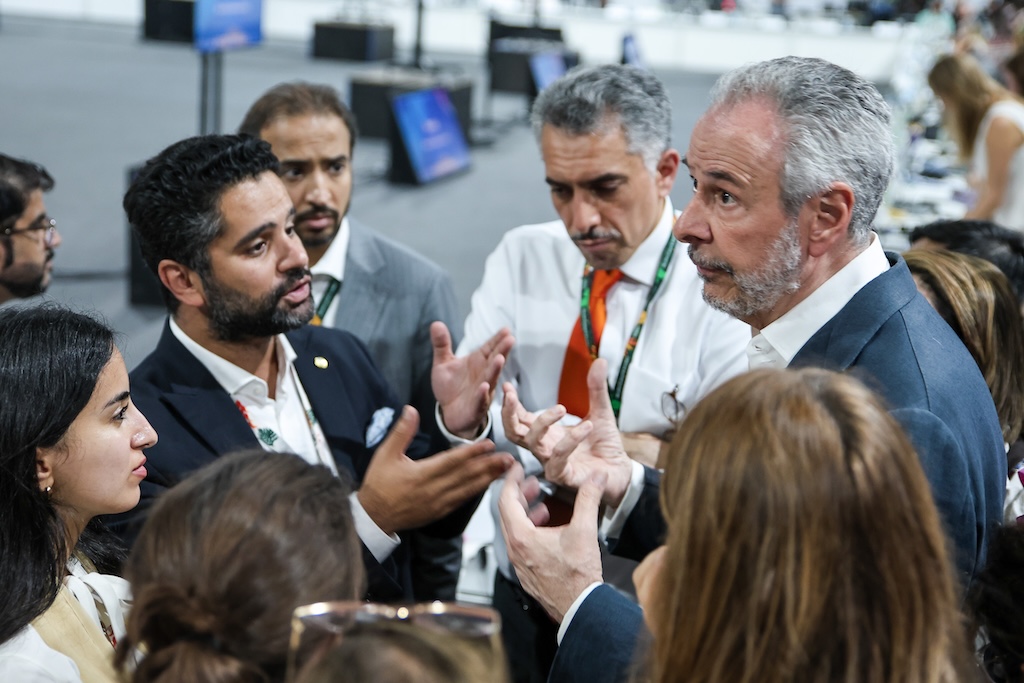
Media characterisations
Some media reporting of the roadmap “blockers” sought to identify the key proponents.
For example, the Sunday Times said “the ‘axis of obstruction’ – Saudi Arabia, Russia and China – blocked the Belém roadmap”.
Agence France-Presse highlighted the views of a French minister who said: “Who are the biggest blockers? We all know them. They are the oil-producing countries, of course. Russia, India, Saudi Arabia. But they are joined by many emerging countries.”
Reuters quoted Vanuatu’s climate minister alleging that “Saudi Arabia was one of those opposed”.
The Financial Times said “a final agreement [was] blocked again and again by countries led by Saudi Arabia and Russia”.
Bloomberg said the roadmap faced “stiff opposition from Arab states and Russia”.
Media coverage in India and China has pushed back at the widespread portrayals of what many other outlets had described as the “blockers” of a fossil-fuel roadmap.
The Indian Express reported:
“India said it was not opposed to the mention of a fossil-fuel phaseout plan in the package, but it must be ensured that countries are not called to adhere to a uniform pathway for it.”
Separately, speaking on behalf of the LMDCs during the closing plenary at COP30, India had said: “Adaptation is a priority. Our regime is not mitigation centric.”
China Daily, a state-run newspaper that often reflects the government’s official policy positions, published a comment article this week stating:
“Over 80 countries insisted that the final deal must include a concrete plan to act on the previous commitment to move beyond coal, oil, and natural gas adopted at COP28…But many delegates from the global south disagreed, citing concerns about likely sudden economic contraction and heightened social instability. The summit thus ended without any agreement on this roadmap.
“Now that the conference is over, and emotions are no longer running high, all parties should look objectively at the potential solution proposed by China, which some international media outlets wrongly painted as an opponent to the roadmap.
“Addressing an event on the sidelines of the summit, Xia Yingxian, deputy head of China’s delegation to COP30, said the narrative on transitioning away from fossil fuels would find greater acceptance if it were framed differently, focusing more on the adoption of renewable energy sources.”
Speaking to Carbon Brief at COP30, Dr Osama Faqeeha, Saudi Arabia’s deputy environment minister, refused to be drawn on whether a fossil-fuel roadmap was a red line for his nation, but said:
“I think the issue is the emissions, it’s not the fuel. And our position is that we have to cut emissions regardless.”
Neither the Arab group nor the LMDCs responded to Carbon Brief’s invitation to comment on their inclusion on the list.
The Brazilian COP30 presidency did not respond at the time of publication.
While the fossil-fuel roadmap was not part of the formal COP30 outcome, the Brazilian presidency announced in the closing plenary that it would take the idea forward under its own initiative, drawing on an international conference hosted in Colombia next year.
Corrêa do Lago told the closing plenary:
“We know some of you had greater ambitions for some of the issues at hand…As president Lula said at the opening of this COP, we need roadmaps so that humanity, in a just and planned manner, can overcome its dependence on fossil fuels, halt and reverse deforestation and mobilise resources for these purposes.
“I, as president of COP30, will therefore create two roadmaps, one on halting and reverting deforestation, another to transitioning away from fossil fuels in a just, orderly and equitable manner. They will be led by science and they will be inclusive with the spirit of the mutirão.
“We will convene high level dialogues, gathering key international organisations, governments from both producing and consuming countries, industry workers, scholars, civil society and will report back to the COP. We will also benefit from the first international conference for the phase-out of fossil fuels, scheduled to take place in April in Colombia.”
Fossil-fuel roadmap
‘Supporters’
Both ‘supporter’ and ‘opposer’
‘Opposers’
Additional reporting by Daisy Dunne.
The post Revealed: Leak casts doubt on COP30’s ‘informal list’ of fossil-fuel roadmap opponents appeared first on Carbon Brief.
Revealed: Leak casts doubt on COP30’s ‘informal list’ of fossil-fuel roadmap opponents
-
Climate Change4 months ago
Guest post: Why China is still building new coal – and when it might stop
-
Greenhouse Gases4 months ago
Guest post: Why China is still building new coal – and when it might stop
-
Climate Change2 years ago
Spanish-language misinformation on renewable energy spreads online, report shows
-

 Greenhouse Gases2 years ago
Greenhouse Gases2 years ago嘉宾来稿:满足中国增长的用电需求 光伏加储能“比新建煤电更实惠”
-
Climate Change Videos2 years ago
The toxic gas flares fuelling Nigeria’s climate change – BBC News
-

 Climate Change2 years ago
Climate Change2 years ago嘉宾来稿:满足中国增长的用电需求 光伏加储能“比新建煤电更实惠”
-

 Carbon Footprint2 years ago
Carbon Footprint2 years agoUS SEC’s Climate Disclosure Rules Spur Renewed Interest in Carbon Credits
-
Renewable Energy5 months ago
US Grid Strain, Possible Allete Sale






